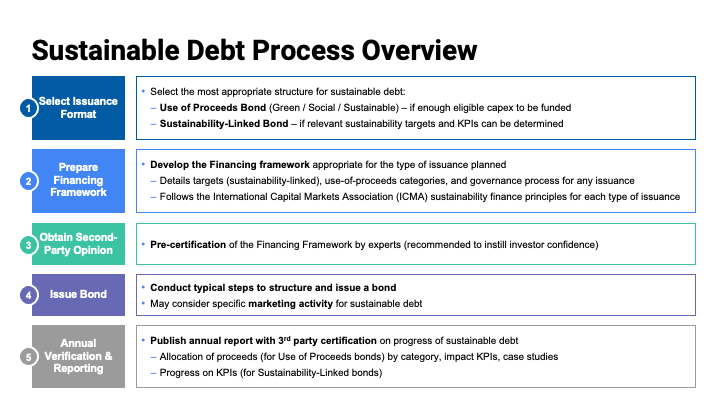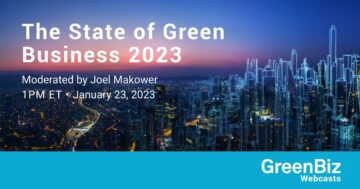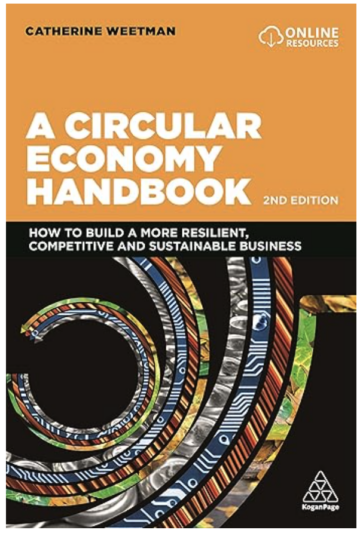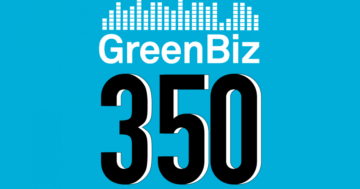The value of bonds issued with metrics for sustainability, social or ESG performance reached $939 billion in 2023, off from more than $1 trillion in 2021 but an increase from the previous year, according to new Bloomberg data.
Media company Comcast was among corporations adding to that total, with its first $1 billion green bond, issued in February 2023. Early signs indicate that 2024 will bring another modest increase, according to S&P Global.
The biggest chunk of that sustainable debt will go to “green bonds,” which fund projects such as solar and wind farms, energy efficiency measures, greener building construction, water conservation, and other investments needed to reach a net-zero economy, said Melissa James, vice chairman of global capital markets and head of the ESG Center of Excellence. Social bonds were the least common. She was speaking during a session Tuesday at GreenBiz 24.
“The whole idea … is to really harness the power of the capital markets for the purpose of investing in sustainable activities, or signaling your sustainability stewardship to the market,” said James.
Sustainability bonds come in four varieties:
- Green bonds, used to finance projects that address adaptation or mitigation of climate change, pollution prevention or biodiversity conservation.
- Social bonds, for funding basic infrastructure, essential services, job creation and so on.
- Sustainability bonds, which include both green and social proceeds designations.
- Sustainability-linked bonds, intended to reward a company for achieving a performance metric related to ESG commitments; the proceeds can be used broadly.
Right now, most sustainable debt issues are green bonds, which generated $575 billion in 2023, according to Bloomberg data. So far, $421.8 million of the proceeds from the Comcast issuance have been allocated to green building projects, clean transportation and clean energy initiatives, according to the company’s bond report, issued in October.
“I think for us, it was a way to kind of demonstrate the tangible sustainability investments that we were making to investors, particularly to investors interested in that space, and that would be interested in this kind of bond,” said Sara Cronenwett, senior vice president for corporate environmental sustainability at Comcast. “It’s also a way to signal to our employees, and to customers, the intent to put dollars behind projects that are helping us reduce our carbon footprint and helping us become a more sustainable company.”
Leave time for internal and external education
Comcast began planning for its green bond 18 months before it was issued, largely because it worked with outside advisors and the company’s finance team to consider what type of bond to offer and how to market it, Cronenwett said. The company’s treasury department “was the decider; they felt it would give us access to some new investors and saw it as valuable to participate,” she said.
The planning cycle is far shorter — a matter of months — for real estate investment trust Prologis, which issued 27 green bonds through January 2023. The company recently updated its rules to align with its science-based targets, said Suzanne Fallender, vice president of ESG at Prologis.
Don’t reinvent the wheel
First-time issuers should consult their bankers to get an idea of the range of options and the amount of time it takes, the panelists said. “We didn’t do it as fast as we humanly could have,” said Cronenwett. “But you can leverage other frameworks that are out there to get a really good sense of what’s required and leverage your bankers to get that information.”
The chart below lists some steps in that process:

Consider evaluation criteria thoroughly
Green bond issuers are required to document their use of proceeds through reports that are audited independently. Developing the financial framework can require months for a first-time issuer. It will need to consider a number of factors that signal how investors can expect the money to be spent and how a company will prove money is being used appropriately.
“With investors, it’s a way for you to outline what you plan to do with the capital from your issuance, or if you’re doing the sustainability-linked bond route, what those [key performance indicators] are that you’ve selected for your company, why they’re material to your business, the targets that you’re setting, and why those are ambitious,” said Lindsay Brent, director of debt capital markets and sustainable finance with Morningstar Sustainalytics, which issues opinions about green bonds.
That mission statement must be aligned with the guidelines set out by the International Capital Market Association.
Test the narrative
The level of detail required is not to be underestimated, said Cronenwett. The trail of proof to support performance indicators is “rigorous,” and companies should plan for that. “This is company debt. Whether it’s green debt or regular debt, it’s debt, and you’ve got to treat it that way,” she said. “So business units still need to justify projects, we still need to decide … those projects, do they have the [return on investment] or other reason to fund them?”
“Before taking an issue to market, companies should be really thoughtful, be really methodical, be really intentional about identifying what it is you’re doing, how you’re doing it, how you’re operationalizing, their strategy, and ensure that you do have the rigor and integrity around your structure such that you minimize the likelihood that you get criticism from the market or from any constituents,” James said.
One example of what not to do, James said, would be to issue a sustainability-linked bond — which has rates that adjust based on ESG performance — because you are virtually certain you already meet the criteria needed. It’s better to raise the bar than simply check the boxes, she said. “You really need to do something that is above and beyond.”
- SEO Powered Content & PR Distribution. Get Amplified Today.
- PlatoData.Network Vertical Generative Ai. Empower Yourself. Access Here.
- PlatoAiStream. Web3 Intelligence. Knowledge Amplified. Access Here.
- PlatoESG. Carbon, CleanTech, Energy, Environment, Solar, Waste Management. Access Here.
- PlatoHealth. Biotech and Clinical Trials Intelligence. Access Here.
- Source: https://www.greenbiz.com/article/what-comcast-learned-issuing-its-1-billion-green-bond
- :has
- :is
- :not
- ][p
- $1 billion
- 1
- 2021
- 2023
- 2024
- 27
- 8
- a
- About
- above
- access
- According
- achieving
- activities
- adaptation
- adding
- address
- adjust
- advisors
- align
- aligned
- allocated
- already
- also
- ambitious
- among
- amount
- an
- and
- Another
- any
- appropriately
- ARE
- around
- AS
- At
- audited
- bankers
- bar
- based
- basic
- BE
- because
- become
- been
- before
- began
- behind
- being
- below
- Better
- Beyond
- Biggest
- Billion
- Bloomberg
- bond
- Bonds
- both
- boxes
- brent
- bring
- broadly
- Building
- business
- but
- by
- CAN
- capital
- Capital Markets
- carbon
- carbon footprint
- Center
- Center of Excellence
- certain
- chairman
- change
- Chart
- check
- clean
- clean energy
- Climate
- Climate change
- Comcast
- come
- commitments
- Common
- Companies
- company
- Company’s
- CONSERVATION
- Consider
- construction
- consult
- Corporate
- Corporations
- could
- creation
- criteria
- criticism
- Customers
- cycle
- data
- Debt
- decide
- demonstrate
- Department
- detail
- developing
- didn
- Director
- do
- document
- doing
- dollars
- Early
- economy
- efficiency
- employees
- energy
- energy efficiency
- ensure
- environmental
- Environmental Sustainability
- ESG
- essential
- essential services
- estate
- Ether (ETH)
- evaluation
- example
- Excellence
- expect
- external
- factors
- far
- Farms
- FAST
- February
- felt
- finance
- financial
- First
- Footprint
- For
- four
- Framework
- frameworks
- from
- fund
- funding
- generated
- get
- Give
- Global
- Go
- good
- got
- Green
- greener
- guidelines
- harness
- Have
- head
- helping
- How
- How To
- HTTPS
- i
- idea
- identifying
- if
- in
- include
- Increase
- independently
- indicate
- Indicators
- information
- Infrastructure
- initiatives
- integrity
- intended
- intent
- Intentional
- interested
- internal
- investing
- investment
- Investments
- Investors
- issuance
- issue
- Issued
- Issuer
- issuers
- issues
- issuing
- IT
- ITS
- james
- January
- Job
- Key
- Kind
- largely
- learned
- least
- Level
- Leverage
- likelihood
- lindsay
- Lists
- Making
- Market
- Markets
- material
- Matter
- measures
- Meet
- methodical
- metric
- Metrics
- million
- minimize
- Mission
- Mission Statement
- mitigation
- modest
- money
- months
- more
- Morningstar
- most
- must
- Need
- needed
- net-zero
- New
- now
- number
- october
- of
- off
- offer
- on
- Opinions
- Options
- or
- Other
- our
- out
- outline
- outside
- participate
- particularly
- performance
- plan
- planning
- plato
- Plato Data Intelligence
- PlatoData
- Pollution
- power
- president
- Prevention
- previous
- proceeds
- process
- projects
- proof
- Prove
- purpose
- put
- raise
- range
- Rates
- RE
- reach
- reached
- real
- real estate
- really
- reason
- recently
- reduce
- regular
- reinvent
- related
- Reports
- require
- required
- return
- Reward
- rigorous
- Route
- rules
- s
- S&P
- Said
- saw
- selected
- senior
- sense
- Services
- session
- set
- setting
- she
- should
- Signal
- Signs
- simply
- So
- so Far
- Social
- solar
- some
- something
- Space
- speaking
- spent
- Statement
- Steps
- Stewardship
- Still
- Strategy
- structure
- such
- support
- Sustainability
- sustainable
- T
- takes
- taking
- tangible
- targets
- team
- than
- that
- The
- The Capital
- their
- Them
- There.
- they
- Think
- this
- those
- Through
- time
- to
- Total
- trail
- transportation
- treasury
- Treasury Department
- treat
- Trillion
- Trust
- Tuesday
- type
- units
- updated
- us
- use
- used
- Valuable
- value
- Ve
- vice
- Vice Chairman
- Vice President
- virtually
- was
- Water
- Way..
- we
- were
- What
- whether
- which
- whole
- why
- will
- wind
- wind farms
- with
- worked
- would
- would give
- year
- you
- Your
- zephyrnet









